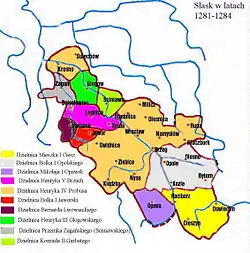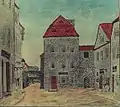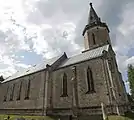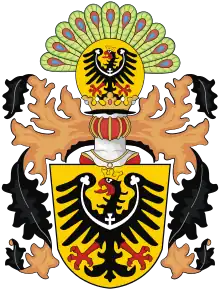Duchy of Löwenberg | |||||||||
|---|---|---|---|---|---|---|---|---|---|
| 1281–1286 | |||||||||
 Coat of arms
| |||||||||
 Silesia in 1284: Lwowek Duchy in burgundy | |||||||||
| Status | Silesian duchy | ||||||||
| Capital | Lwowek Slaski | ||||||||
| Religion | catholic | ||||||||
| Government | feudalism | ||||||||
| Historical era | Middle Ages | ||||||||
• Partitioned from Jawor | 1281 | ||||||||
• Annexed by Jawor | 1286 | ||||||||
| |||||||||
The Duchy of Löwenberg (German: Herzogtum Löwenberg) or Duchy of Lwowek (Polish: Księstwo Lwóweckie) was one of the Duchies of Silesia established in 1281 as a division of the Duchy of Jawor. The duchy of Lwowek was ruled by the Silesian Piast, Bernard the Lightsome, with its capital at Lwowek Slaski (German: Löwenberg) in Lower Silesia, which gained town rights in 1217.
Geography
The original duchy was located in the south-western part of Lower Silesia on the current lands of Lwowek Sląski County with the southern part of the duchy covering most of the modern Jelenia Gora County. Lwowek Slaski was the biggest town (around 11.000 inhabitants.[1]) and also the capital of the duchy. The town of Lwowek had its own mint[2][3] and coin.[4][5] The town had double walls and two big churches. Some other important towns located within the lands of the duchy were: Wlen (German: Lähn), Gryfow Sląski (German: Greiffenberg) and Jelenia Gora (German: Hirschberg).[6] The main factor of the rapid development of the area was gold surrounding Lwowek Slaski and the trade road Via Regia. Some sources say that a few tons of gold were excavated in the Middle Ages from the mines around Lwowek.[7] After the exhaustion of the gold mines the citizens started to earn from cloth producing, weaving, crafts, trade and sandstone processing.
History

Bernard the Lightsome was the only ruler of the duchy of Lwowek. He was the youngest son of the Silesian prince Boleslaw II Rogatka and Hedwig, daughter of Henry I, Count of Anhalt. He became the ruler 3 years after his father died, in 1281 when Bernards' brother Bolko I the Strict partitioned the Duchy of Jawor and granted him western part of the duchy with its capital in Lwowek Slaski. The Duchy of Jawor and the duchy of Lwowek cooperated as brothers ruled in the two duchies. Bernard died unmarried and childless in 1286 and because of a lack of heirs the duchy of Lwowek was annexed and ruled by the Duchy of Jawor again by Bernard's brother Bolko I.[8][9][10]
Castles
There were several castles guarding the lands of the duchy. The most important were those located in Wlen, Gryfow and Lwowek.
Lwowek Castle
Lwowek Castle (Polish: Zamek książęcy w Lwówku Śląskim German: Löwenberg) was a medieval castle in Lwowek built to protect the inhabitants of the town. It was built at the beginning of the 13th century as a seat of Silesian princes. It was located in the southern part of the town, along the town walls. The founder of the castle was probably Henry I the Bearded.[11] The castle was often visited by princes of Jawor and Swidnica-Jawor (for example Bolko I the Strict). The castle was partly destroyed during a fire in 1381 but the town council decided to rebuild the castle and in 1389 the renovation was complete. Since 1444 the castle was no longer a public property. The castle was destroyed again in 1475 after a huge fire and has never been rebuilt again. Now in the place of the castle stands the oldest brewery in Poland which started producing beer in 1209.[12] The only remains of the castle are the sandstone foundations in the brewery's basement.[13][14]
 Lwowek Brewery - the former location of the castle
Lwowek Brewery - the former location of the castle
Gryf Castle

Gryf Castle (Polish: Zamek Gryf, German: Greiffenstein) is located in Proszowka near Gryfow. The first owner of the castle was Konrad II the Hunchback.
.jpg.webp) Gryf Castle on the top of the hill (447 m a.s.l.)
Gryf Castle on the top of the hill (447 m a.s.l.).jpg.webp) Remainings of the Gryf Castle
Remainings of the Gryf Castle Ruins
Ruins.jpg.webp) A part of Gryf Castle
A part of Gryf Castle.jpg.webp) Castle gate
Castle gate
Wlen Castle
Wlen Castle (Polish: Zamek Wleń German: Lähnhaus) is located in Łupki near Wleń.
_(9)_ID_596187.jpg.webp) Wlen Castle
Wlen Castle_(6)_ID_596187.jpg.webp) The main tower of the castle
The main tower of the castle1.jpg.webp) Remains
Remains2.jpg.webp) Path to the castle
Path to the castle Map of the castle
Map of the castle
There were also many medieval guard towers along Via Regia road.
Gallery
 Medieval bas-relief on the south wall of the town hall in Lwowek Slaski - a symbol of the town, with a sentence written in latin which means "Fair as a lion"
Medieval bas-relief on the south wall of the town hall in Lwowek Slaski - a symbol of the town, with a sentence written in latin which means "Fair as a lion".svg.png.webp) Medieval coat of arms of the town of Lwowek Slaski
Medieval coat of arms of the town of Lwowek Slaski Modern coat of arms of the town of Lwowek Slaski
Modern coat of arms of the town of Lwowek Slaski.JPG.webp) Medieval fortifications of Lwowek Slaski
Medieval fortifications of Lwowek Slaski Tower of Lubanian Gate - a place of a former town gate in Lwowek Slaski
Tower of Lubanian Gate - a place of a former town gate in Lwowek Slaski.JPG.webp) The high town wall of Lwowek Slaski (of double surrounding walls in general)
The high town wall of Lwowek Slaski (of double surrounding walls in general) Tower of Boleslawieckan Gate in Lwowek Slaski
Tower of Boleslawieckan Gate in Lwowek Slaski Tower of Złotoryjan Gate in Lwowek
Tower of Złotoryjan Gate in Lwowek Guard tower in Rakowice Wielkie
Guard tower in Rakowice Wielkie Big church in Lwowek
Big church in Lwowek Church of st. Hedwig in Gryfow
Church of st. Hedwig in Gryfow Town walls of Gryfow
Town walls of Gryfow.jpg.webp) Houses in Gryfow
Houses in Gryfow Church in Wlen
Church in Wlen
References
- ↑ Staffa, Marek (2003). Słownik geografii turystycznej Sudetów, Pogórze Izerskie. [1], A-Ł. Wrocław: I-BiS. pp. 443–471. ISBN 83-85773-60-6.
- ↑ "WCN :: A67/232". wcn.pl. Retrieved 2018-11-18.
- ↑ https://4.bp.blogspot.com/-R74cpTX6nww/WR3LoKxXjdI/AAAAAAAAAUA/Ozrhnonug6wrXJpdI69NNyjVNXFd65dAACLcB/s1600/110.JPG
- ↑ https://foto.wcn.pl/67/full/67_0239r.jpg
- ↑ Kalinowski, Piotr (2009). Pieniądz miasta Lwówek Śląski. Kalety: Wydawnictwo Piotr Kalinowski. p. 4. ISBN 978-83-61755-19-7.
- ↑ "Map of the Duchy".
- ↑ "samorodek.com".
- ↑ Kazimierz (1920-1997) Jasiński (19 March 2013). "Bernard Zwinny". Retrieved 2017-09-04.
{{cite web}}: CS1 maint: numeric names: authors list (link) - ↑ Michał Szuster. "Bernard Zwinny (Zręczny, Skoczek) - POCZET.COM" (in Polish). www.poczet.com. Retrieved 2017-09-04.
- ↑ Krystian Krawczyk (2013-02-19). "DOLNY ŚLĄSK: Księstwo świdnicko-jaworskie". DOLNY ŚLĄSK. Retrieved 2018-11-04.
- ↑ zerojeden, dariusz sitko. "Lwówek Śląski - Zamek w Lwówku Śląskim - OPIS - (Polskie zamki)". www.zamki.pl. Retrieved 2018-11-18.
- ↑ "Lwówek - najstarszy browar w Polsce - pawelskiersinis.pl". pawelskiersinis.pl (in Polish). 2015-07-16. Retrieved 2018-11-18.
- ↑ Kulesza, Małgorzata. "Zamki polskie - Zamek w Lwówku Śląskim - Lwówek Ślaski". www.zamkipolskie.net.pl. Retrieved 2018-11-18.
- ↑ "Turniej rycerski w średniowiecznym Lwówku - Tajemnice Dolnego Śląska". tajemnicedolnegoslaska.cba.pl (in Polish). Retrieved 2018-11-18.

